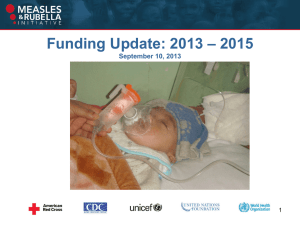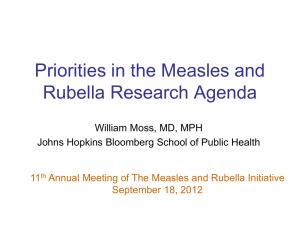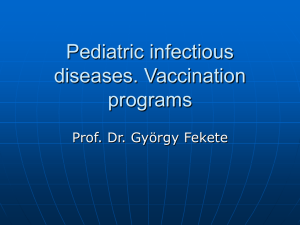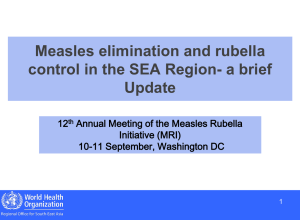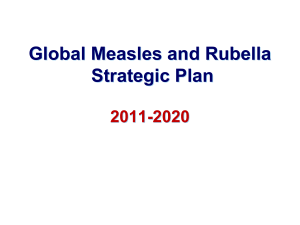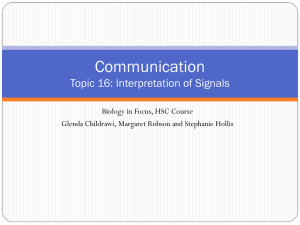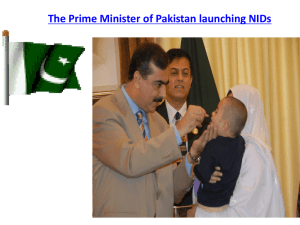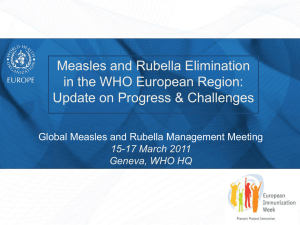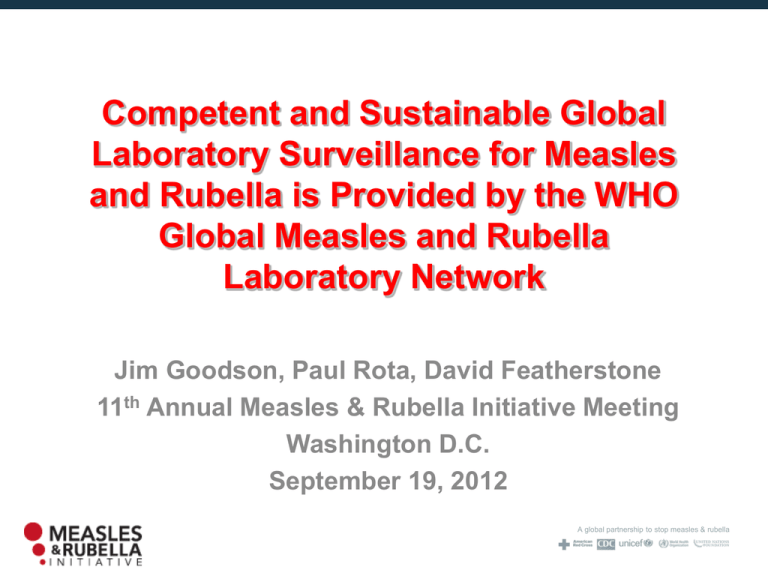
Competent and Sustainable Global
Laboratory Surveillance for Measles
and Rubella is Provided by the WHO
Global Measles and Rubella
Laboratory Network
Jim Goodson, Paul Rota, David Featherstone
11th Annual Measles & Rubella Initiative Meeting
Washington D.C.
September 19, 2012
A global partnership to stop measles & rubella
A global partnership to stop measles & rubella
Quick Quiz…
A global partnership to stop measles & rubella
What's causing these fever
Measles
and rash cases?
HHV-6
Rubella
A global partnership to stop measles & rubella
Countries Conducting Measles Case-Based
Surveillance with Laboratory Testing in 2011
Case-based measles surveillance
implementation status at national level
Yes
(181 countries or 94%)
No
(12 countries or 6%)
A global partnership to stop measles & rubella
6
WHO Global Measles and Rubella Laboratory
Network (LabNet): 2012
N= 690 labs
10 Sub-National Labs
2012
N= 690 labs
31 Prov. Labs
+ 331 Prefect. Labs
184/194 countries served by proficient labs
National Laboratories
Regional Reference Labs
Global Specialised Labs
Provincial Labs China
Sub-National Labs Russia
A global partnership to stop measles & rubella
LabNet Plays a Critical Role in Measles and
Rubella Control Programs
•Laboratory confirmation of suspected cases of measles and
rubella
•Detection of measles/rubella specific IgM in a serum or
oral fluid sample taken at first contact with patient
•Detection of viral RNA in an appropriately collected clinical
sample
•Isolation of virus in cell culture
•Genetic characterization of circulating strains for molecular
epidemiology analysis
•Measurement of population immunity
A global partnership to stop measles & rubella
Structure of the WHO Global Measles and
Rubella Laboratory Network (LabNet)
•Multiple layers (similar to polio lab network)
Global Specialized Labs (CDC-Atlanta, HPA-London, NIID-Japan)
Regional Reference Labs (molecular biology, cell culture,
sequencing)
National Labs and sub national networks (sample collection, EIA,
some molecular testing and cell culture)
Management and supervision
Lab Coordinator at WHO Geneva (annual meeting)
GSL
Regional Lab Coordinators at WHO Regional Offices
Financial support
Host country/institute
RRL
NL
WHO, CDC, MR Initiative, Others
A global partnership to stop measles & rubella
Strengths of the LabNet Structure
Standardized testing and reporting structure
Excellent quality control at all levels
High quality data reported with stringent timeliness requirements
Use of lab data linked with epi data to drive public health
decisions
Local ownership and alignment with national public health
priorities
National laboratories are nominated by MOH in collaboration with
WHO
Integrated surveillance for measles and rubella and other VPDs
(e,g, Yellow Fever and Japanese Encephalitis)
A global partnership to stop measles & rubella
Major Activities of the Measles and Rubella
LabNet
• Serologic testing for detection of measles
and rubella IgM
• Training and Capacity Building
• Standardization
• Quality Control
• Verification of Elimination
• Virologic Surveillance
A global partnership to stop measles & rubella
Activity: Serologic Testing: IgM test results as reported to
WHO HQ by WHO region, 2010 & 2011
Measles375,012
and Rubella tests
2010-11
(N=
tests)
70000
60000
Rubella
results
No. of test results
50000
Rub Pos
40000
Rub Equiv
30000
Measles
Rub Neg
results
Meas Pos
Meas Equiv
Meas Neg
20000
10000
0
2010
2011
AFR
2010
2011
AMR
2010
2011
EMR
2010
2011
EUR
2010
2011
SEAR
2010
2011
WPR
As of May 31, 2012: N= 74,504 tests
Activity: Training and Capacity Building
•
•
•
Training workshops
Multifunctional
• Measles, Rubella, YF, JE
• Serological, molecular, data analysis
Continual process:
• Staff attrition
• New methods
• QA processes
• Molecular techniques
• Data management
• Laboratory management
A global partnership to stop measles & rubella
Activity: Capacity Building for 2012
Region
Focus
Planned
quarter
AFR
YF, M&R, Mol
IgM/QA
1st -3rd
quarters
W&C, E&S
AMR
Molecular
3rd
NLs
EMR
Molecular
2nd
Mol Labs
EUR
IgM
2nd
TUR
EUR
Molecular
3rd
Mol Labs
WPR
Molecular
4th
Mol labs
WHO Vaccine Preventable Disease Lab Network
Participants
Activity: Standardization
2012 WER nomenclature articles published
– Measles virus: published 2 March 2012
• Genotype D11 was verified
• Decisions were made on subgenotypes
• 6 genotypes not detected since 2000
• 5 genotypes not detected since 2006
• Protocols were made accessible on WHO genotype database
– Mumps virus: published 1 June 2012
• Nomenclature and genotype classification
• Reference strains revised
• Global distribution of genotypes reported, including map
– Rubella virus Nomenclature update
• planned for late 2012 - early 2013
A global partnership to stop measles & rubella
Activity: Quality Assurance
A proficiency testing (PT) panel for serology is sent
annually from VIDRL, in Melbourne
– 180 laboratories participating with excellent results
A PT for molecular techniques is being planned
Regular laboratory accreditation processes including
site visits
A global partnership to stop measles & rubella
15
Meeting the Need for Enhanced Surveillance
Oral fluid samples (OF)
– AFR
• 5 country trial: Zimbabwe, Malawi, Kenya, Benin, CIV
– SEAR
• India and Sri Lanka good correlation with serum but
highlighted need for adequate training of surveillance staff
– EUR
• France tested >3500 OFs in recent measles outbreak
Point of care
– Refinements of sample type and field testing is
underway
WHO Vaccine Preventable Disease Lab Network
Activity: Verification of Elimination of Measles
and Rubella
• Monitoring of surveillance performance indicators
• ≥80% of confirmed outbreaks with a sample for
virus detection and genotyping
• Determining population immunity using
serosurveys to validate reported vaccination
coverage
A global partnership to stop measles & rubella
Activity: Virologic Surveillance for
Measles and Rubella
Molecular epidemiology is a key component of the verification
process for measles and rubella elimination
A criterion for elimination is the absence of an
endemic genotype for one year
Genetic data in conjunction with standard epidemiologic
information can be used to track transmission patterns and
identify sources of infection
A global partnership to stop measles & rubella
Measles D4 (Enfield strain) distribution Mar 2007–Dec 2011
As of 01 July 2012
Aug 07
Dec 08 (MA)
Jun 08 (CA)
Jan 09 (CA)
Mar 07Dec 11
Apr 07
Jan 08
Feb 08
Oct 08
Nov 07
Feb 08
Apr 08 x3
Jun-Jul
08
Dec 08
Aug 08
Mar-May 08
Aug 08
XX 08 (JAM)
Dec 08 (IL)
May 2010
Acknowledgements:
WHO Measles LabNet esp
HPA, Lux, RKI & CDC
Measles Surveillance
Programmes
The boundaries and names shown and the designations used on this map do not imply the
expression of any opinion whatsoever on the part of the World Health Organization
concerning the legal status of any country, territory, city or area or of its authorities, or
concerning the delimitation of its frontiers or boundaries.
Dotted lines on maps represent approximate border lines for which there may not yet be full
agreement.
WHO 2008. All rights reserved
LabNet Genetic Sequence Data as of July 2012
Viruses submitted dating from 1954 to 2012
WHO
Databases
(started 2006)
No. of
viruses
Genotypes
Countries
and
Territories
Proportion with
GenBank entries
Measles
13,312
All 24
135
32%
Rubella
1,302
All 9
+ 4 prov.
49
22%
MeaNS database (HPA/WHO, started
2008)
N – 450bp – 9632 sequences
N – full – 3 sequences
H – full – 592 sequences
A global partnership to stop measles & rubella
13192_MVs/Sgor.MYS/21.11/_15
95.8%
13190_MVs/Kuala_Lumpur.MYS/21.11/_14
14162_MVs/Klumpur.MYS/21.11/_13
2562_MVs/New_York.USA/1.05/_14
1529_MVs/VEN/02/_13
2547_MVi/Santander.COL/31.02/_13
87.4%
8811_MVs/PHL/0.08/7/D9_13
30_MVs/Bristol.GBR/15.05/_13
0%
G3
200
B2
D6
150
D5
D9
100
D8
H1
50
2857_MVs/Halifax.GBR/33.04/_16
2022_MVi/Yamagata.JPN/3.04/_15
2023_MVi/Yamagata.JPN/5.04/_15
2024_MVs/Yamagata.JPN/7.04/_15
2025_MVs/Yamagata.JPN/7.04/2_15
2026_MVs/Yamagata.JPN/7.04/3_15
10271_MVs/Saitama.JPN/5.11/_15
18754_MVs/Tokyo.JPN/03.11/2_15
18799_MVs/Tokyo.JPN/05.11/_15
11192_MVs/Arizona.USA/06.11/_15
9614_MVs/Ontario.CAN/49.10/D9_17
76.6%
9705_MVs/Ontario.CAN/52.10/D9_17
9741_MVs/Ontario.CAN/01.11/D9_17
9897_MVs/Aichi.JPN/46.10/_16
9916_MVs/Christchurch.NZL/6.11/3_18
82%
9983_MVs/Christchurch.NZL/8.11/D9_18
10127_MVs/Ontario.CAN/7.11/1_18
18609_MVs/Newsouthwales.AUS/9.11/_17
18611_MVs/Newsouthwales.AUS/10.11/_17
18612_MVs/Newsouthwales.AUS/11.11/_17
18613_MVs/Newsouthwales.AUS/11.11/2_17
18614_MVs/Newsouthwales.AUS/11.11/3_17
18615_MVs/Newsouthwales.AUS/12.11/2_17
18616_MVs/Newsouthwales.AUS/12.11/3_17
18617_MVs/Newsouthwales.AUS/12.11/_17
2012
2010
2008
2006
2004
2002
78.9%
2000
0
1998
93.1%
250
1996
53.7%
2621_MVs/London.GBR/22.08/9_18
3033_MVs/Reading.GBR/24.08/_18
1994
91.8%
3364_MVs/Alkmaar.NLD/09.09/_341
3251_MVs/Nis.SRB/45.08/_15
85.8%
3548_MVi/Lopburi.THA/8.08/_15
3549_MVi/Lopburi.THA/8.08/7_15
3551_MVi/Khonkaen.THA/9.08/4_15
3826_MVs/London.GBR/1.09/_16
3860_MVs/London.GBR/4.09/_16
0%3918_MVs/Ipswich.GBR/12.09/_16
3980_MVi/Yamagata.JPN/12.09/_15
4032_MVi/Moscow.RUS/12.09/3_15
4035_MVi/Moscow.RUS/11.09/3_15
4036_MVi/Moscow.RUS/11.09/4_15
4037_MVi/Moscow.RUS/11.09/5_15
4038_MVi/Moscow.RUS/10.09/_15
4041_MVs/Moscow.RUS/41.08/_15
4044_MVs/Irkutsk.RUS/12.09/_15
4045_MVs/Irkutsk.RUS/13.09/_15
4046_MVi/Krasnoyarsk.RUS/13.09/_15
4047_MVs/Krasnoyarsk.RUS/15.09/_15
4048_MVs/Krasnoyarsk.RUS/17.09/_15
15052_MVs/Bremerhaven.DEU/35.08/_16
15059_MVs/Muenchen.DEU/13.09/_16
19806_MVs/London.GBR/11.12/2_16
20230_MVs/Medway.GBR/14.12/_16
20692_MVs/Medway.GBR/14.12/2_16
20923_MVs/Watford.GBR/15.12/_16
20926_MVs/Medway.GBR/14.12/3_16
20934_MVs/Medway.GBR/15.12/_16
21889_MVs/Samut-Prakan.THA/8.11/_16
22268_MVi/Yunnan.CHN/2.12/_15
MVi/Yangon.MMR/1.12/1D9
MVi/Yangon.MMR/8.12/1D9
MVi/Yangon.MMR/8.12/2D9
MVi/Yangon.MMR/11.12/2D9
2572_MVi/Sarawak.MYS/2.05/_13
2573_MVs/Victoria.AUS/14.04/_13
4707_MVs/Manila.PHL/19.07/2_13
13411_MVs/California.USA/17.10/_13
0%22275_MVi/California.USA/20.10/_14
1992
88.3%
3822_MVs/Colchester.GBR/4.09/_16
3830_MVs/Colchester.GBR/3.09/_16
3855_MVs/Colchester.GBR/10.09/_16
3896_MVs/Cambridge.GBR/7.09/_16
4305_MVs/Newcastle_upon_Tyne.GBR/22.09/_16
3373_MVs/Granada.ESP/25.08/_15
3552_MVi/Phare.THA/27.08/_14
3558_MVs/Maastricht.NLD/22.08/_14
84.3%
5067_MVs/Villeneuve.FRA/28.08/_14
6168_MVs/Villeneuve-stGeorges.FRA/26.08/_14
6171_MVs/Nice.FRA/18.08/_14
6173_MVi/Nice.FRA/20.08/_14
6174_MVi/Nice.FRA/20.08/2_14
90%
3550_MVi/Khonkaen.THA/9.08/2_15
12324_MVs/Hiroshima.JPN/14.11/_16
0%
MVi/Yangon.MMR/7.12/1D9
12464_MVs/Osaka.JPN/14.11/_16
51.1%
65.2%
1990
.11/3_12
MeaNS: Global Measles Sequence Database
Allows Real Time Reporting and Analysis of
Sequence Data
MeaNS: Circulating genotypes
A
1980
1981
1982
1983
1984
1985
1986
1987
1988
1989
1990
1991
1992
1993
1994
1995
1996
1997
1998
1999
2000
2001
2002
2003
2004
2005
2006
2007
2008
2009
2010
2011
2012
B1
B2
B3
C1
C2
D1
D2
D3
D4
D5
D6
D7
D8
D9 D10 D11
E
F
G1 G2 G3 H1
H2
0
0
0
0
1
0
0
0
0
0
0
0
2
0
0
0
0
0
0
0
0
0
0
0
0
0
0
0
1
0
1
0
0
0
0
0
0
0
0
0
0
0
0
0
0
0
0
0
0
0
0
0
0
0
0
0
0
0
0
0
1
0
0
0
0
0
0
0
0
0
0
0
0
1
0
0
1
0
1
0
0
0
0
0
0
0
0
0
0
0
0
2
0
0
0
0
0
0
7
0
3
1
0
0
0
0
0
0
0
0
0
0
0
0
0
0
0
0
0
0
0
0
0
0
1
0
0
0
0
0
0
0
3
0
0
0
0
0
0
0
0
0
0
0
0
0
0
0
0
0
1
1
0
0
0
0
2
0
0
0
0
0
0
0
0
0
0
0
0
0
0
0
0
0
0
0
1
0
0
0
1
0
0
0
0
1
0
0
0
0
0
0
1
0
0
0
0
0
0
2
1
0
0
0
2
0
0
0
0
0
0
0
0
0
0
0
1
0
0
0
0
0
0
1
2
3
0
0
1
0
0
0
0
0
0
0
0
0
0
0
0
0
0
0
0
3
0
0
2
1
0
1
0
0
0
0
0
0
0
0
0
0
0
0
0
0
0
1
0
5
0
0
0
0
0
0
0
0
0
0
0
0
0
0
0
0
0
0
0
0
0
0
1
4
0
0
2
0
0
0
0
0
0
0
0
0
0
0
0
0
5
0
1
0
0
4
0
2
0
0
0
0
2
0
0
0
0
0
0
0
0
0
0
0
9
0
0
0
0
2
0
2
0
0
2
3
4
2
0
2
0
0
0
0
1
0
0
0
10
2
1
0
0
0
0
0
0
0
0
9
0
0
0
0
0
0
0
0
0
0
0
0
3
0
2
0
0
0
0
11
0
0
0
0
1
4
0
0
0
0
0
0
0
0
0
0
0
0
1
0
0
22
0
3
0
0
11
6
8
23
0
2
0
0
0
0
0
0
6
0
4
1
0
0
0
49
0
6
0
0
11
8
9
10
0
2
0
0
0
0
0
0
1
0
2
2
1
0
0
8
0
5
0
0
13
9
1
3
1
7
3
0
0
0
0
0
1
3
15
0
0
0
4
28
0
3
0
1
5
6
21
7
5
0
0
14
0
0
0
0
5
0
37
1
1
0
0
84
0
0
0
10
9
6
80
40
13
2
0
13
1
0
0
0
4
0
76
1
2
0
0
22
0
1
0
4
7
38
41
2
12
5
2
1
0
0
0
0
0
2
69
1
4
0
0
37
0
11
0
4
7
53
6
11
62
115
1
34
0
0
0
0
0
0
80
6
10
0
1
27
0
14
0
0
3
105
16
14
3
16
7
0
1
0
0
0
1
2
57
0
3
0
27
36
0
0
0
1
0
46
12
20
0
56
4
2
0
0
0
0
0
0
139
0
6
0
21
364
0
0
0
0
0
149
34
108
0
58
2
0
0
0
0
0
0
3
195
0
3
0
0
9
0
1
0
0
0
550
132
18
1
59
1
0
0
0
0
0
0
4
175
0
5
0
1
9
0
0
0
0
0
422
113
0
0
72
21
0
0
0
0
0
0
0
157
0
1
0
10
79
0
0
0
0
0
294
13
0
0
39
23
0
5
0
0
0
0
0
32
0
3
0
52
335
0
0
0
0
3
533
0
0
0
75
39
0
0
0
0
0
0
24
56
0
7
0
7
224
0
0
0
0
0 1777
0
0
0
220
171
0
0
0
0
0
0
51
5
0
1
0
0
258
0
0
0
0
0
0
0
0
74
49
0
0
0
0
0
0
0
0
0
284
1 - 10
10 - 100
> 100
Distributionof
ofmeasles
measles genotypes,
2012.
Data
as of
2012
Distribution
genotypes,
2011.
Data
as19
ofJune
1919
June
2012
Distribution
of
measles
genotypes,
2011.
Data
as
of
June
2012
Viruses =2946
Genotypes = 8
Countries = 74
West Africa inset
West Europe
Genotypes:
Incidence:
(per 100'000)
B2
<0.1
B3
≥0.1 - <1
D4
≥1 - <5
D8
≥5
D9
No data reported
D11
G3
H1
Chart proportional to
number of genotypes
5
1
0
2'500
5'000 Kilometers
A global partnership to stop measles & rubella
Acknowledgement: WHO Measles LabNet.
The boundaries and names shown and the designations used on this map do not imply the expression of any opinion whatsoever on the part of the World Health Organization
concerning the legal status of any country, territory, city or area or of its authorities, or concerning the delimitation of its frontiers or boundaries. Dotted lines on maps represent
approximate border lines for which there may not yet be full agreement.
©WHO 2011. All rights reserved.
Distribution of reported rubella genotypes, 2011. Data as of 3 August 2012
West Europe
2011
120 countries reporting laboratory confirmed rubella
12 countries reporting genotype information
Legend
1a
1E
Pie slice size proportional to the
number of years each genotype
was reported 2005-2011.
1j
5
1
2B
0
2'500
5'000 Kilometers
A global partnership to stop measles & rubella
Acknowledgement: WHO LabNet.
The boundaries and names shown and the designations used on this map do not imply the expression of any opinion whatsoever on the part of the World Health Organization
concerning the legal status of any country, territory, city or area or of its authorities, or concerning the delimitation of its frontiers or boundaries. Dotted lines on maps represent
approximate border lines for which there may not yet be full agreement.
©WHO 2011. All rights reserved.
Measles and Rubella LabNet Challenges (1)
Financial support to maintain laboratory activities
Financial support to expand case based surveillance for measles
and rubella (especially GAVI countries)
Staff turnover (RLCs, GLC) and training needs
Need to maintain and expand sequence databases
Better use of date by linking epi and lab data in Africa
Expansion in India
Introduction of new methods (Molecular)
Maintain and expand QC/QA Program
Integration with surveillance for other VPDs
Development of testing strategies for low incidence settings
A global partnership to stop measles & rubella
26
Measles and Rubella LabNet Challenges (2)
Molecular surveillance plays a vital role in
monitoring progress with rubella control and in
verification of elimination
Large gaps in surveillance for rubella virus
Baseline data should be collected well before
acceleration of activities for control
Global rubella sequence database (RubeNS)
under development
Enhance laboratory capacity in GAVI eligible
countries
A global partnership to stop measles & rubella
Global Measles and Rubella LabNet Estimated Costs 2011
$1,600,000
$1,400,000
Estimated shortfall
shortfall
Estimated
$1,300,000
$1,300,000
$1,200,000
Shortfall
Funds Identified 2011
Shortfall met
$1,000,000
$800,000
$600,000
$400,000
$200,000
$0
Lab Support
Meetings
Consumables
Kits
WHO Vaccine Preventable Disease Lab Network
Training
Travel
Equipment
Global Measles and Rubella LabNet Projected Budget, 2012
Total :
$4,376,000
Shortfall : $900,000
Summary
Strong capacity: >200,000 IgM tests, 3,000 measles
sequences and 330 rubella sequences annually
Proficiency high -- closely monitored and maintained
Molecular surveillance is becoming increasingly important
for monitoring progress of elimination and verification
Still gaps in molecular surveillance, especially for rubella
Financial support for the LabNet is tenuous
Search for new coordinator is ongoing
A global partnership to stop measles & rubella
Summary
10th Annual Measles and
Rubella LabNet Meeting: 2012
30
Anne Ray Charitable Trust
A global partnership to stop measles & rubella
31

